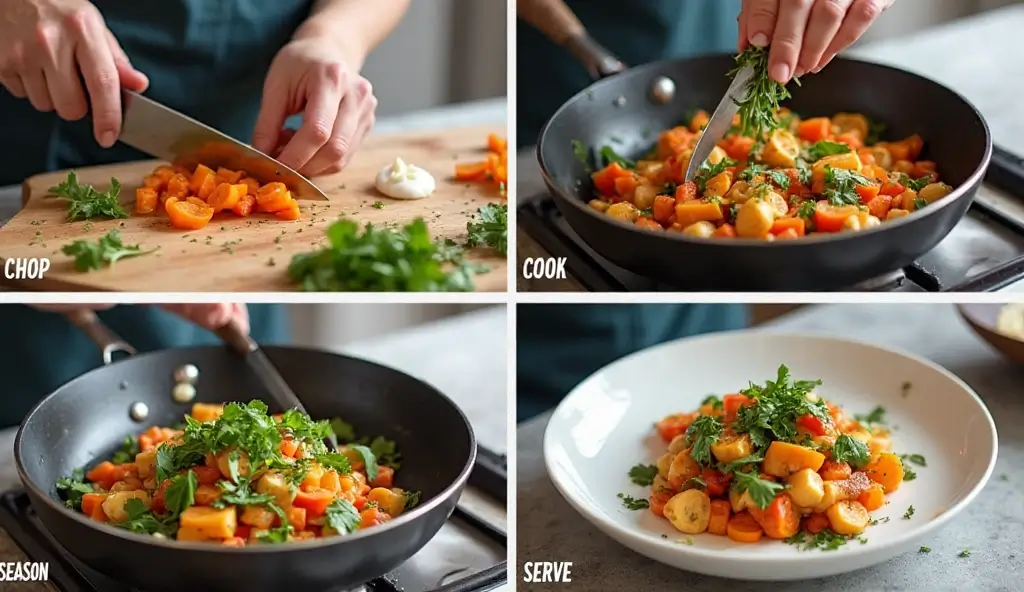Are you feeling drained and in need of a revitalizing boost? If so, you’re not alone. Many people struggle with low energy levels, especially those dealing with autoimmune issues. Fortunately, AIP diet recipes can help you reclaim your vitality. By focusing on nutrient-dense, whole foods, these recipes not only support digestive health but also reduce inflammation. In addition, they are designed to be delicious and satisfying, making it easier to stick to your dietary goals.
According to the National Institutes of Health, diets focused on nutrient-dense, anti-inflammatory foods—like the AIP diet—may improve quality of life for people with autoimmune diseases.
Table of Contents
In this culinary journey, you will discover a variety of AIP diet recipes that are not only easy to prepare but also packed with flavor. Whether you are a seasoned chef or a kitchen novice, you will find step-by-step instructions that guide you through each recipe. Moreover, we will explore the essential ingredients that make these dishes both compliant and delightful. So, if you’re ready to enhance your energy levels and enjoy wholesome meals, let’s dive into the world of AIP diet recipes together!
Key Benefits of AIP Diet Recipes
When it comes to reclaiming your energy, AIP diet recipes are a fantastic choice. Not only do they focus on nutrient-dense, whole foods, but they also offer numerous health benefits that can transform your well-being. Here’s why you might want to consider incorporating these recipes into your daily meals:
- Energy Boost: AIP diet recipes are designed to support your energy levels. By eliminating inflammatory foods, you may notice a significant increase in your vitality.
- Inflammation Reduction: Many people find that following the autoimmune protocol helps reduce inflammation in their bodies. Consequently, this can lead to less pain and discomfort.
- Digestive Health: AIP recipes often include ingredients that promote gut health. For example, fresh vegetables and lean proteins can aid digestion and improve nutrient absorption.
- Nutrient-Dense Ingredients: These recipes prioritize whole foods, which means you’re getting a wealth of vitamins and minerals. This is especially important for those managing chronic illnesses.

In addition to these benefits, AIP diet recipes are versatile and can be tailored to suit your taste preferences. Whether you’re looking for a hearty stew or a refreshing salad, there’s an AIP recipe for you. So, why not give them a try? You might just find your new favorite dish!
Ingredients for AIP Diet Recipes
When it comes to crafting delicious AIP diet recipes, the right ingredients are essential. Not only do they need to be compliant with the autoimmune protocol, but they also should be fresh and nutrient-dense. Here’s a handy list to guide you through your ingredient selection:
- Fresh Vegetables: Think leafy greens, carrots, zucchini, and sweet potatoes. These vibrant veggies are packed with vitamins and minerals that support your health.
- Lean Proteins: Opt for grass-fed meats, wild-caught fish, and pasture-raised poultry. These options are not only AIP-compliant but also provide essential amino acids for energy.
- Healthy Fats: Incorporate avocado oil, coconut oil, and olive oil. These fats are crucial for maintaining energy levels and promoting overall well-being.
- Herbs and Spices: Fresh herbs like basil, parsley, and cilantro can elevate your dishes. Additionally, spices such as turmeric and ginger offer anti-inflammatory benefits.
- Compliant Ingredients: Always check labels for additives. Look for ingredients that are gluten-free, dairy-free, and free from nightshades.
- Seasonal Produce: Whenever possible, choose seasonal fruits and vegetables. They are often fresher, tastier, and more nutrient-rich.

As you gather your ingredients, remember that quality matters. For instance, organic options are preferable, as they are free from harmful pesticides. If you can’t find a specific ingredient, don’t worry! You can often substitute with something similar. For example, if you’re out of fresh herbs, dried herbs can work in a pinch, although you should use less since they are more concentrated.
Moreover, if you have dietary restrictions or preferences, feel free to modify the list. The beauty of AIP diet recipes is their flexibility. So, whether you’re cooking for yourself or your family, these ingredients will help you create meals that are not only compliant but also delicious and satisfying.
How to Make AIP Diet Recipes
Creating delicious and energizing AIP diet recipes is easier than you might think! Follow these simple steps to whip up meals that not only taste great but also support your health journey. Let’s dive in!
- Gather Your Ingredients: Start by collecting all your AIP-compliant ingredients. This typically includes fresh vegetables, lean proteins, and healthy fats. For example, consider using organic chicken, sweet potatoes, and a variety of seasonal veggies. Having everything ready will make the cooking process smoother.
- For guidance on safe food handling and ingredient prep, visit the USDA’s food safety resource center.
- Prep Your Veggies: Wash and chop your vegetables into bite-sized pieces. Remember, uniform sizes help them cook evenly. For instance, if you’re using carrots and zucchini, cut them into similar thicknesses. This way, they’ll be perfectly tender when served.
- Choose Your Cooking Method: Decide how you want to cook your meal. You can roast, sauté, or steam your ingredients. For a quick option, sautéing in olive oil or coconut oil works wonders. Just be sure to keep an eye on the heat to avoid burning.
- Season Wisely: AIP recipes thrive on flavor, so don’t shy away from herbs and spices! Use fresh herbs like basil or thyme, and spices like turmeric or ginger, which are not only compliant but also add a delightful taste. However, avoid any non-compliant seasonings like black pepper.
- Cook to Perfection: Follow the cooking times for each ingredient. For example, root vegetables like sweet potatoes may take longer to cook than leafy greens. Thus, add them to the pan first and then introduce the quicker-cooking veggies afterward.
- Taste and Adjust: Once everything is cooked, taste your dish. If it needs a little something extra, consider adding a splash of lemon juice or a sprinkle of sea salt. This step is crucial, as it enhances the overall flavor profile of your AIP diet recipe.
- Serve and Enjoy: Finally, plate your meal beautifully. A colorful presentation can make a big difference. Consider garnishing with fresh herbs or a drizzle of olive oil. Not only does this make your dish look appealing, but it also adds an extra layer of flavor.

By following these steps, you’ll create AIP diet recipes that are not only nutritious but also bursting with flavor. Remember, cooking is an adventure, so feel free to experiment with different ingredients and techniques. Enjoy your culinary journey!
Pro Tips, Variations & Common Problems
Cooking AIP diet recipes can be a delightful journey, but it’s not without its challenges. Here are some pro tips to help you navigate the kitchen with confidence and creativity.
Pro Tips
– **Prep Ahead:** Meal prep is your best friend. Chop vegetables and marinate proteins in advance. This way, you can whip up AIP diet recipes quickly during busy days.
– **Flavor Boosters:** Use fresh herbs and AIP-compliant spices to enhance flavors. For example, fresh basil or rosemary can elevate a simple dish.
– **Texture Matters:** If you’re aiming for a creamy texture, consider using blended cauliflower or coconut milk. These ingredients can add richness without dairy.
Creative Variations
– **Swap Proteins:** Feel free to substitute chicken with turkey or fish. This keeps your meals exciting and allows you to explore different flavors.
– **Vegetable Choices:** Experiment with seasonal vegetables. For instance, swap zucchini for butternut squash in your recipes to change things up.
– **Add Crunch:** If you miss the crunch of nuts, try using toasted pumpkin seeds or sunflower seeds as a topping for salads or soups.
Common Problems & Solutions
– **Texture Issues:** If your dish turns out too mushy, it might be overcooked. To avoid this, keep an eye on cooking times and test for doneness regularly.
– **Seasoning Problems:** A common mistake is under-seasoning. Always taste your dish before serving. If it lacks flavor, add a pinch of salt or a splash of lemon juice to brighten it up.
– **Overcooking Proteins:** To prevent dry meat, use a meat thermometer. Aim for the right internal temperature, and remember that proteins continue to cook slightly after being removed from heat.
– **Ingredient Availability:** If you can’t find a specific ingredient, don’t hesitate to look for alternatives. For example, if you’re out of coconut aminos, a splash of apple cider vinegar can work in a pinch.
By keeping these tips in mind, you’ll not only enhance your cooking skills but also enjoy the process of creating delicious AIP diet recipes. Remember, cooking is all about experimenting and finding what works best for you!
Serving Suggestions for AIP Diet Recipes
When it comes to serving AIP diet recipes, presentation can elevate your meal from simple to spectacular. Here are some delightful ideas to make your dishes shine, ensuring they not only taste great but also look inviting.
Plating Ideas
Start by choosing a beautiful plate that complements the colors of your dish. For instance, a vibrant salad can pop against a white or dark plate. Additionally, consider the following tips:
- Use a ring mold to stack ingredients for a layered look.
- Drizzle sauces or purees artistically around the plate for a gourmet touch.
- Garnish with fresh herbs or edible flowers to add a splash of color.

Side Dish Pairings
Pair your AIP diet recipes with complementary side dishes to create a balanced meal. Here are some ideas:
- Serve roasted sweet potatoes alongside grilled chicken for a hearty combination.
- A side of sautéed greens, such as kale or spinach, adds a nutrient boost.
- Consider a refreshing cucumber salad to cleanse the palate.
Creative Serving Options
Whether you’re hosting a casual dinner or an elegant gathering, how you serve your AIP diet recipes can set the mood:
- For a family-style setting, place dishes in the center of the table, allowing everyone to help themselves.
- For a more formal occasion, serve individual portions on elegant dinnerware, perhaps with a small appetizer to start.
- Consider a picnic-style presentation with dishes laid out on a colorful tablecloth, perfect for outdoor gatherings.
Presentation Tips
Finally, remember that the little details can make a big difference:
- Use cloth napkins and stylish utensils to enhance the dining experience.
- Light candles or add fresh flowers to the table for a warm ambiance.
- Don’t forget to serve drinks that complement your meal, such as herbal teas or infused water.
By incorporating these serving suggestions, your AIP diet recipes will not only nourish the body but also delight the senses. Enjoy the process of creating beautiful meals that your family and friends will love!
Preserving and Reheating AIP Diet Recipes
When it comes to enjoying your AIP diet recipes later, proper storage and reheating are key to maintaining their delicious flavor and satisfying texture. Let’s dive into some practical tips that will help you keep your meals fresh and tasty!
Storage Tips
First and foremost, storing your AIP diet recipes correctly is essential. For short-term storage, refrigerate your meals in airtight containers. This method keeps them fresh for about 3 to 5 days. If you want to store them for a longer period, freezing is your best bet. Most AIP meals can be frozen for up to 3 months without losing quality. To maximize freshness, consider vacuum-sealing your dishes. This technique removes air, which helps prevent freezer burn and keeps flavors intact.
Additionally, always label your containers with the date and contents. This simple step helps you keep track of what you have and when it needs to be consumed. Food safety is paramount, so remember to cool your meals to room temperature before refrigerating or freezing them. This practice helps prevent bacterial growth, ensuring your meals stay safe and delicious.
Reheating Methods
Now that your AIP diet recipes are stored properly, let’s talk about reheating them. The best way to reheat your meals is in the oven or on the stovetop, as these methods help preserve texture and flavor. For oven reheating, preheat to 350°F (175°C). Place your meal in an oven-safe dish, cover it with foil to retain moisture, and heat for about 15-20 minutes. This way, your dish warms evenly without drying out.
If you prefer the stovetop, simply add a splash of water or broth to your pan. Heat over medium-low, stirring occasionally, until warmed through. This method not only warms your food but also refreshes its flavors. Alternatively, if you’re in a hurry, the microwave can be used. However, be cautious! Heat in short intervals of 30 seconds, stirring in between, to avoid hot spots and overcooking.
Lastly, if you have an air fryer, it’s a fantastic option for reheating. Set it to a low temperature, around 300°F (150°C), and heat for about 5-10 minutes. This method can give your meals a delightful crispiness, making them feel freshly cooked. By following these tips, you can enjoy your AIP diet recipes just as much the second time around, ensuring they remain a source of energy and nourishment!
Conclusion
As we wrap up this delightful journey into the world of AIP diet recipes, let’s take a moment to reflect on the key steps we’ve explored together. From selecting fresh, compliant ingredients to mastering simple cooking techniques, this recipe showcases the versatility and ease of preparing meals that nourish both body and soul. Remember, cooking doesn’t have to be complicated; it can be a joyful experience that brings energy and vitality back into your life. I wholeheartedly encourage you to give this recipe a try. You might be surprised at how satisfying and delicious AIP meals can be!
Share Your Experience
I would love to hear about your culinary adventures! Please feel free to share your results or ask any questions you may have. Additionally, don’t hesitate to experiment with variations or pairings that suit your taste. Cooking is all about creativity, and AIP diet recipes provide a fantastic canvas for you to express yourself in the kitchen. So, gather your ingredients, roll up your sleeves, and enjoy the process. Happy cooking!
What is the AIP diet?
The AIP diet, or Autoimmune Protocol diet, is designed to help reduce inflammation and support healing in individuals with autoimmune conditions. It focuses on eliminating certain foods that may trigger symptoms, such as grains, dairy, legumes, and processed foods, while emphasizing nutrient-dense, whole foods.
Can I eat fruits on the AIP diet?
Yes, you can enjoy fruits on the AIP diet! However, it’s best to focus on low-sugar options like berries and green apples. Additionally, moderation is key, as some fruits can be higher in sugar, which may affect your energy levels.
How do I know if a recipe is AIP-compliant?
To determine if a recipe is AIP-compliant, check the ingredients list for any prohibited items like grains, dairy, legumes, nuts, and seeds. Instead, look for recipes that use compliant ingredients such as fresh vegetables, lean proteins, and healthy fats.
What are some easy AIP diet recipes for beginners?
For beginners, simple AIP diet recipes include roasted vegetables, grilled chicken with herbs, and hearty soups made with compliant ingredients. These recipes are not only easy to prepare but also delicious and satisfying, helping you stay on track with your dietary goals.
How can I make meal prep easier on the AIP diet?
Meal prep can be a breeze on the AIP diet! Start by planning your meals for the week and batch-cooking compliant recipes. Additionally, use airtight containers to store your meals, and consider freezing portions for later use. This way, you’ll always have healthy, energizing meals ready to go!

aip diet recipes
Ingredients
Method
- Start by collecting all your AIP-compliant ingredients. This typically includes fresh vegetables, lean proteins, and healthy fats.
- Wash and chop your vegetables into bite-sized pieces.
- Decide how you want to cook your meal. You can roast, sauté, or steam your ingredients.
- Use fresh herbs and spices to enhance flavor.
- Follow the cooking times for each ingredient.
- Taste your dish and adjust seasoning as needed.
- Plate your meal beautifully and enjoy!
Notes
| Calories | Fat | Protein | Carbs |
|---|---|---|---|
| 350 | 15g | 30g | 25g |

